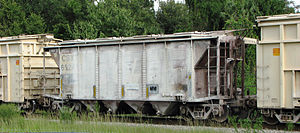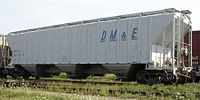|
|
| Line 1: |
Line 1: |
| − | {{honor_header|2|1967|Arts and Crafts|General Conference}}
| + | [[Image:6619.JPG|right|thumb|300px|Covered hopper car originally built in the 1950s for the [[Atlantic Coast Line Railroad]]. After the 1967 SCL merger these cars were fitted with rotary couplers and used in [[Bone Valley]] phosphate service.]] |
| | + | [[Image:LO DME 49328.jpg|right|thumb|200px|DME 49328, a covered hopper owned and operated by the [[Dakota, Minnesota and Eastern Railroad]].]] |
| | | | |
| − | ==1. Give the history and development of model railroading. ==
| + | A '''covered hopper''' is a [[railroad]] [[freight car]]. Structurally, it is very similar to an open-top [[hopper car]] in that the carbody consists of a large hopper with unloading chutes at the bottom. What distinguishes this type of car from an open hopper is not only the car's roof, but also the car's overall size. Covered hoppers typically carry loads of less dense, and therefore lighter, materials, so they are built to a higher cubic capacity than open top hoppers. They are used predominantly to haul various grains such as [[maize|corn]], [[wheat]] and [[barley]]. |
| − | ==2. Tell the difference in how the following prototype motive power units operate:==
| |
| − | ===a. Steam ===
| |
| − | ===b. Diesel ===
| |
| − | ===c. Electric===
| |
| − | ==3. Know the name, scale, and track gauge for four model railroad gauges.==
| |
| − | The six most popular scales used are: G scale, Gauge 1, O scale, H0 scale (in Britain, the similarly sized 00 is used), TT scale, and N scale (1:160), although there is growing interest in Z scale. H0 scale is the single most popular scale of model railroad. Popular narrow-gauge scales include HOn3 Scale and Nn3, which are the same scale as HO and N, except with a narrower spacing between the tracks (in these examples, a scale three feet instead of the 4'8.5" standard gauge).
| |
| | | | |
| − | The words scale and gauge seem at first to be used interchangeably in model railways, but their meanings are different. Scale is the model's measurement as a proportion to the original, while gauge is the measurement between the two running rails of the track.
| + | Grain hoppers are well designed for long term storage of grain and often retired cars are sold to farmers for use as graineries. |
| | | | |
| − | {| border=1 align="center"
| + | Some covered hoppers are built to carry loads that are heavy, but very susceptible to damage if exposed to the weather. Loads such as [[cement]], processed [[phosphate]], and [[kaolin clay]] are carried, in powdered form, in covered hoppers. Covered hoppers designed for these loads more closely resemble open-top hoppers. |
| − | |-
| |
| − | !Name || Scale || Gauge
| |
| − | |-
| |
| − | | G scale ||1:22.5 || {{units|45 mm|1.75 inches}}
| |
| − | |-
| |
| − | | Gauge 1 ||1:32 ||{{units|44.45 mm|1.75 inches}}
| |
| − | |-
| |
| − | | 0 scale ||1:43 or 1:48 ||{{units|32 mm|1.25 inches}}
| |
| − | |-
| |
| − | | H0 scale ||1:87 ||{{units|16.5 mm|0.65 inches}}
| |
| − | |-
| |
| − | | TT scale ||1:120 ||{{units|12 mm|0.47 inches}}
| |
| − | |-
| |
| − | | N scale ||1:148 to 1:160 || {{units|9 mm|0.354 inches}}
| |
| − | |-
| |
| − | | Z scale ||1:220 ||{{units|6.5 mm|0.256 inches}}
| |
| − | |}
| |
| | | | |
| − | ==4. Know the shapes and names of at least eight track plan arrangements.==
| + | <!-- Deleted image removed: [[Image:Santa Fe Conditionaire Covered Hopper.jpg|thumb|250px|left|ACFX #47633, one of 100 specially-built "[[Refrigerator car#Hopper cars|Conditionaire]]" centerflow hoppers operated by the [[Atchison, Topeka and Santa Fe Railway]] in the late 1960s and early 1970s.]] --> |
| − | ==5. Know at least six points to check for the maintenance of a model railroading layout. ==
| |
| − | ==6. Identify and explain the use of: ==
| |
| − | ===a. Five types of freight cars ===
| |
| − | ==== Covered Hopper ====
| |
| − | [[Image:6619.JPG|thumb|200px|Covered Hopper]] | |
| − | Structurally, a covered hopper is very similar to an opentop hopper car. What distinguishes this type of car from an open hopper is the car's roof, and also the car's overall size. Covered hoppers typically carry loads of less dense, and therefore lighter, materials, so they are built to a higher cubic capacity than open top hoppers.
| |
| | | | |
| − | ====Box Car====
| + | Covered hoppers in [[North America]]n service have been built by most of the freight car manufacturers of the 20th century. The most common covered hoppers that are still in use were built by either [[Pullman-Standard]] or [[American Car and Foundry|ACF]]. |
| | | | |
| − | More Info:
| + | |
| − | * http://www.uprr.com/customers/equip-resources/cartypes/boxcars.shtml
| |
| | | | |
| − | ====Container Car====
| + | {{freight cars}} |
| − | [[Image:Containerzug 100 7207.jpg|thumb|200px|Container cars]]
| |
| − | ====Gondola====
| |
| − | ====Refrigerator Car====
| |
| − | ====Stock Car====
| |
| − | In railroad terminology, a stock car is a type of rolling stock used for carrying livestock (not carcasses) to market. A traditional stock car resembles a boxcar with slats missing in the car's side (and sometimes end) for the purpose of providing ventilation; stock cars can be single-level for large animals such as cattle or horses, or they can have two or three levels for smaller animals such as sheep, pigs, and poultry.
| |
| − | ====Tank Car====
| |
| | | | |
| − | ===b. Three types of passenger cars ===
| + | [[Category:Freight equipment]] |
| − | ===c. Three types of steam engines according to their wheel arrangement ===
| |
| − | ===d. Two types of grade crossing warning devices ===
| |
| − | ===e. Two types of railroad signals ===
| |
| − | ===f. Five types of railroad-related buildings or structures ===
| |
| | | | |
| − | ==7. Know the meaning of the following model railroad terms:==
| + | {{rail-stub}} |
| − | ===a. Ballast===
| |
| − | ===b. Blind drivers===
| |
| − | ===c. Block ===
| |
| − | ===d. Bolster ===
| |
| − | ===e. Crossing ===
| |
| − | ===f. Crossover ===
| |
| − | ===g. Double header ===
| |
| − | ===h. Draft gear ===
| |
| − | ===i. Flange ===
| |
| − | ===j. Frog ===
| |
| − | ===k. Gap ===
| |
| − | ===l. Gauge ===
| |
| − | ===m. Grade ===
| |
| − | ===n. Gravity yard ===
| |
| − | ===o. Hot box ===
| |
| − | ===p. Insulated rail joiner ===
| |
| − | ===q. Journal===
| |
| − | === r. Layout===
| |
| − | === s. Mainline ===
| |
| − | ===t. Prototype ===
| |
| − | ===u. Rail joiner ===
| |
| − | ===v. Reverse loop===
| |
| − | ===w. Siding ===
| |
| − | ===x. Spur ===
| |
| − | ===y. Switch ===
| |
| − | ===z. Machine ===
| |
| − | ===aa. Talgo truck ===
| |
| − | ===bb. Truck ===
| |
| − | ===cc. Turnout ===
| |
| − | ===dd. Two-rail===
| |
| − | ===ee. Wye===
| |
| − | ===ff. Yswitch ===
| |
| − | ===gg. Yard===
| |
| − | ==8. Construct a portion of a model railroad layout. In your construction, do the following: ==
| |
| − | ===a. Assist in assembling the framework ===
| |
| − | ===b. Install a section of ballast ===
| |
| − | ===c. Install a section of track ===
| |
| − | ===d. Install at least one turnout, including the wiring ===
| |
| − | ===e. Assist in making scenery, such as trees, rocks, mountains, or grass ===
| |
| − | ===f. Make one model railroading building or structure ===
| |
| − | ===g. Assist in the wiring to supply electrical power to the tracks ===
| |
| − | ==9. Successfully operate a model railroad train on the layout you have assisted in building. ==
| |
| | | | |
| − | [[Category:Adventist Youth Honors Answer Book|{{SUBPAGENAME}}]] | + | [[de:Offener Güterwagen#Selbstentladewagen]] |

Covered hopper car originally built in the 1950s for the
Atlantic Coast Line Railroad. After the 1967 SCL merger these cars were fitted with rotary couplers and used in
Bone Valley phosphate service.
A covered hopper is a railroad freight car. Structurally, it is very similar to an open-top hopper car in that the carbody consists of a large hopper with unloading chutes at the bottom. What distinguishes this type of car from an open hopper is not only the car's roof, but also the car's overall size. Covered hoppers typically carry loads of less dense, and therefore lighter, materials, so they are built to a higher cubic capacity than open top hoppers. They are used predominantly to haul various grains such as corn, wheat and barley.
Grain hoppers are well designed for long term storage of grain and often retired cars are sold to farmers for use as graineries.
Some covered hoppers are built to carry loads that are heavy, but very susceptible to damage if exposed to the weather. Loads such as cement, processed phosphate, and kaolin clay are carried, in powdered form, in covered hoppers. Covered hoppers designed for these loads more closely resemble open-top hoppers.
Covered hoppers in North American service have been built by most of the freight car manufacturers of the 20th century. The most common covered hoppers that are still in use were built by either Pullman-Standard or ACF.
Template:Freight cars
Template:Rail-stub
de:Offener Güterwagen


